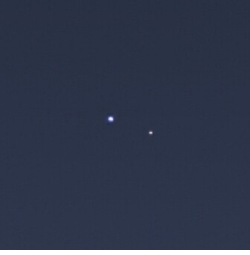Spaceship Earth (Part One)

Earth and Moon From Space
Back in 1802, William Paley wrote one of the most compelling arguments I have ever heard. I read this argument when I was waffling between atheism and agnosticism, and it became one of the most important things I ever learned. Like many others, I tried hard to deny it, but I couldn’t do so without abandoning logic and common sense. I found Paley’s argument to be so powerful, that without considering scripture at all, I simply couldn’t deny the world we live in must be the handiwork of an intelligent Creator.
So powerful is this evidence of creation that I cannot address it properly in a single post. Instead, “Spaceship Earth” is the first post in a series I hope you will find as compelling as I do. First, I will present Paley’s original observation, and then I will rewrite it by including some scientific facts we know today. In fairness to those who might be trying hard to deny God, like I once was, I’ll include some objections, and it is my hope that everyone who reads this will eventually come to the same understanding I have today; “It’s much harder to deny this evidence than to accept it.” Here is what Paley wrote:
“In crossing a heath, suppose I pitched my foot against a stone, and were asked how the stone came to be there; I might possibly answer, that, for anything I knew to the contrary, it had lain there forever: nor would it perhaps be very easy to show the absurdity of this answer. But suppose I had found a watch upon the ground, and it should be inquired how the watch happened to be in that place; I should hardly think of the answer I had before given, that for anything I knew, the watch might have always been there. … There must have existed, at some time, and at some place or other, an artificer or artificers, who formed [the watch] for the purpose which we find it actually to answer; who comprehended its construction, and designed its use. … Every indication of contrivance, every manifestation of design, which existed in the watch, exists in the works of nature; with the difference, on the side of nature, of being greater or more, and that in a degree which exceeds all computation.”
—William Paley, Natural Theology (1802)
What is Paley saying? He’s making the observation that if he were walking in the woods, and happened upon a pocket watch, after looking at the complexity of the instrument, he would know it was made by someone. It would be obvious and undeniable, even if he never saw a pocket watch before. The gears, engravings, and complexity of its workings, would make it obvious to anyone that it was not something that happened by accident, some strange rock formation, but something that was invented/created by some intelligent watch maker. Wouldn’t we all know that? How much denial would you have to be in to come across a pocket watch and deny it was created by someone? If you can deny that, then you can deny anything–even the obvious.
Paley goes on to say that if you cannot deny a watch you stumbled upon was created by an intelligent watchmaker, then you cannot look at the world and deny it too had a creator, because the world is more complex and intricate than a watch.
I could end this series right here. Paley’s observations, alone, are powerful enough to convince anyone, except maybe those who don’t want to believe what is apparent. As powerful as Paley’s observations are, what we know from science today makes me even more certain that the world is not the result of random chance–and I can’t wait to share some of it with you, but first let me ask, “How much proof do you need?”
I have long understood that we rarely have 100% certainty about anything. Even an honest atheist would be hard pressed to claim they have 100% certainty. Before I would believe the world was created, I needed a lot of proof. I don’t mean that I needed 51% proof (a preponderance of the evidence) before I believed. I needed proof beyond a reasonable doubt before I could really believe. The same amount of proof we need before we convict someone of murder.
If you would support convicting a murder suspect, or letting a convicted man out of prison, based on DNA evidence, then your standard of proof, in life or death scenarios, is something like 7000 to 1–that’s the actual certainty in practice during the typical murder trial. But if you didn’t know that, and you assumed that all DNA evidence is like a pristine DNA sample under perfect laboratory conditions, then your standard of proof might be much greater, something more like 1,000,000,000 (one billion) to 1 (odds).
Think about this. In cases of life and death, your standard of proof might actually be much lower, like eye witness testimony, or fingerprints, but at most your standard might be perfect DNA evidence, 1 billion to 1 (odds). Maybe convicting a murderer is a bad example for you, so call it paternity testing if you like. Either way, if you accept perfect DNA results as evidence, then you have demonstrated you form strong beliefs based on strong evidence (odds), and probably weaker evidence if you are honest about it.
 You might be surprised to learn that the odds of the world existing by accident are MUCH smaller than the odds of a pristine DNA test being wrong. If I prove those odds to you, wouldn’t you have to believe the world was created? Of course you would; after all, you believe lower standards of proof are sufficient to make life and death decisions. Disbelieving would be irrational.
You might be surprised to learn that the odds of the world existing by accident are MUCH smaller than the odds of a pristine DNA test being wrong. If I prove those odds to you, wouldn’t you have to believe the world was created? Of course you would; after all, you believe lower standards of proof are sufficient to make life and death decisions. Disbelieving would be irrational.
According to science, the odds that the world happened by accident are basically 0 (zero–no chance). To help you understand, the chances of winning the PowerBall Jackpot are roughly 1 in 175,223,510. Let’s round that off and call it 1 in 175 with 6 zeros after it. The odds of pristine DNA matches are 1 in 1 with nine zeros after it. According to science, the chances that the universe happened by accident are more like 1 in 1 with 138 zeros after it! I could write that out, but it would just look like a sea of zeros.
It’s hard to make sense of such large numbers. Consider this; if you added up all the atoms in the whole universe, the number of atoms is roughly 1 with 70 zeros after it. The odds that the universe was designed are so large that it’s fair to call it 100% because it eclipses even the sum total of all atoms that exist–but if you prefer to think about it as 1 with 138 zeros to 1 (odds), then that’s OK too.
After reading this evidence, some atheists will still disbelieve, but others will read this, and change their minds because it is proof beyond any reasonable doubt.
This is Astonishing if it’s true! It is, but what I find really astonishing is that many people don’t know this already, probably because they simply don’t want to know. More astonishing still, some people know these facts and still claim they don’t believe the universe was created. That is truly mind boggling.
Spaceship Earth (Part Two) — Coming soon.
